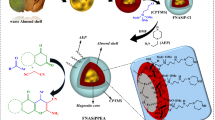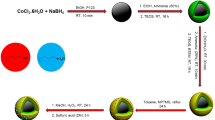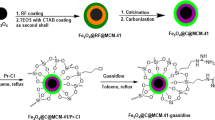Abstract
Core–shell magnetic sulfonated melamine formaldehyde including tris(hydrogensulfato) boron [Fe3O4@SMF@THSB] and melamine trisulfonic acid [Fe3O4@SMF@MTSA] has been successfully fabricated via the encapsulation of magnetic iron oxide cores in sulfonated melamine–formaldehyde (SMF) followed by surface modification with tris(hydrogensulfato) boron [THSB] or melamine trisulfonic acid [MTSA]. The core–shell structure of the synthesized nanoparticles was characterized through several analytical and spectroscopic methods including Fourier transform infrared spectroscopy (FT-IR), X-ray diffraction (XRD), scanning electron microscopy (SEM), transmission electron microscopy (TEM), Brunauer–Emmett–Teller (BET) analysis, Barret–Joyner–Halenda (BJH) analysis, vibrating sample magnetometer (VSM), energy-dispersive X-ray (EDX) spectroscopy, and thermal gravimetric analysis (TGA). It was observed that the thermal stability of both nanocomposites is near 300 °C, particle-size distribution around 5–60 nm, and surface area of 3.9 and 4.9 m2/g for Fe3O4@SMF@THSB and Fe3O4@SMF@MTSA, respectively. Besides the above findings, the active acidic sites of the resultant composites which have been lead to the polarity of the catalyst surface made them excellent catalysts in comparison with similarly reported composites towards the synthesis of biologically active biscoumarin derivatives. Interestingly, the polar surface of the composites accelerates the adsorption of polar substrates onto the catalyst surface as well as the desorption of nonpolar products. Also, the magnetic properties of the nanocomposites provide advantages for easy separation and recovery of the catalysts from the reaction system by using an external magnetic field. Besides, both Fe3O4@SMF@THSB and Fe3O4@SMF@MTSA have been used for five successive catalytic runs without any considerable loss in activity.
Graphical abstract
Recent research is focused on the fabrication and characterization of two new crystalline Fe3O4@SMF@THSB and Fe3O4@SMF@MTSA nanocomposites and their application in the synthesis of biscoumarin derivatives





Similar content being viewed by others
Data availability
The authors declerate that the data supporting the findings of this study are available within the paper and its Supplementary information files.
References
Sheldon RA, van Bekkum H (2001) in Fine Chemicals through Heterogeneous Catalysis, 1st edn. Wiley-VCH, Weinheim
Li S, Meng Lin M, Toprak MS, Kim DK, Muhammed M (2010) Nanocomposites of polymer and inorganic nanoparticles for optical and magnetic applications. Nano Rev 1:5214. https://doi.org/10.3402/nano.v1i0.5214
Baig RBN, Varma RS (2013) Magnetic silica-supported ruthenium nanoparticles: an efficient catalyst for transfer hydrogenation of carbonyl compounds. ACS Sustain Chem Eng 1:805–809. https://doi.org/10.1021/sc400032k
Burke NAD, Stöver HDH, Dawson FP (2002) Magnetic nanocomposites: preparation and characterization of polymer-coated iron nanoparticles. Chem Mater 14:4752–4761. https://doi.org/10.1021/cm020126q
Aydın A, İmamoğlu M, Gülfen M (2008) Separation and recovery of gold (III) from base metal ions using melamine–formaldehyde–thiourea chelating resin. J Appl Polym Sci 107:1201–1206. https://doi.org/10.1002/app.27178
Gümüş G, Demirata B, Apak R (2000) Simultaneous spectrophotometric determination of cyanide and thiocyanate after separation on a melamine-formaldehyde resin. Talanta 53:305–315. https://doi.org/10.1016/S0039-9140(00)00485-9
Roberts RJ, Evans PD (2005) Effects of manufacturing variables on surface quality and distribution of melamine formaldehyde resin in paper laminates. Compos A: Appl Sci Manuf 36:95–104. https://doi.org/10.1016/j.compositesa.2003.05.001
Nemli G, Usta M (2004) Influences of some manufacturing factors on the important quality properties of melamine-impregnated papers. Build Environ 39:567–570. https://doi.org/10.1016/j.buildenv.2003.12.008
Shieh JY, Wang CS (2001) Synthesis of novel flame retardant epoxy hardeners and properties of cured products. Polymer 42:7617–7625. https://doi.org/10.1016/S0032-3861(01)00257-9
Xue SW, Li J, Xu L (2017) Preparation of magnetic melamine-formaldehyde resin and its application to extract nonsteroidal anti-inflammatory drugs. Anal Bioanal Chem 409:3103–3113. https://doi.org/10.1007/s00216-017-0251-8
Wang P, Zhao Y, Liu J (2018) Versatile design and synthesis of mesoporous sulfonic acid catalysts. Sci Bull 63:252–266. https://doi.org/10.1016/j.scib.2018.01.017
Lv Z, Sun Q, Meng X, Xiao FS (2013) Superhydrophilic mesoporous sulfonated melamine–formaldehyde resin supported palladium nanoparticles as an efficient catalyst for biofuel upgrade. J Mater Chem A 1:8630–8635. https://doi.org/10.1039/C3TA10916J
Zarnaghash N, Rezaei R, Hayati P, Doroodmand MM (2019) Selective ultrasonic assisted synthesis of iron oxide mesoporous structures based on sulfonated melamine formaldehyde and survey of nanorod/sphere, sphere and core/shell on their catalysts properties for the Biginelli reaction. Mater Sci Eng C 104:109975. https://doi.org/10.1016/j.msec.2019.109975
Kiasat AR, Fallah-Mehrjardi M (2008) A novel and efficient solid acid catalyst for the regioselective conversion of epoxides to thiocyanohydrins under solvent-free conditions. J Braz Chem Soc 19:1595–1599. https://doi.org/10.1590/S0103-50532008000800020
Sajjadifar S, Zolfigol MA, Chehardoli G (2020) Boron sulfuric acid as an efficient heterogeneous catalyst for the synthesis of 1-substituted 1H–1,2,3,4-tetrazoles in polyethylene glycol. Eurasian Chem Commun 2:812–818. https://doi.org/10.34945/SAMI/ECC.2020.7.8
Safaei HR, Davoodi M, Shekouhy M (2013) Boron sulfuric acid as an efficient heterogeneous catalyst for the synthesis of 1-substituted 1H–1,2,3,4-tetrazoles in polyethylene glycol Synth. Commun 43:2178–2190. https://doi.org/10.1080/00397911.2012.696300
Soheilizad M, Adib M, Sajjadifar S (2014) One-pot and solvent-free synthesis of aliphatic and aromatic1H-indazolo[2,1-b] phthalazinetriones catalyzed by boron sulfonic acid. Monatsh Chem 145:1353–1356. https://doi.org/10.1007/s00706-014-1194-9
Shirini F, Albadi J (2010) Melamine trisulfonic acid as a new, efficient and reusable catalyst for the chemoselective oxathioacetalyzation of aldehydes. Bull Korean Chem Soc 31:1119–1120. https://doi.org/10.5012/bkcs.2010.31.5.1119
Chehardoli G, Zolfigol MA, Faal-Rastegar T, Mallakpour S, Ghorbani-Choghamarani A (2009) 1,3,5-Triazine-2,4,6-triyltrisulfamic acid (TTSA): a new organic solid acid for the nitrosation of secondary amines and oxidation of urazoles in the presence of NaNO2 under mild and heterogeneous conditions. J Chem Sci 121:441–447. https://doi.org/10.1007/s12039-009-0052-5
Yang XJ, Zhang YS (2013) Melamine trisulfonic acid-catalyzed N-formylation of amines under solvent-free conditions. Res Chem Intermed 39:2843–2848. https://doi.org/10.1007/s11164-012-0803-7
Hamdi N, Puerta MC, Valerga P (2008) Synthesis, structure, antimicrobial and antioxidant investigations of dicoumarol and related compounds. Eur J Med Chem 43:2541–2548. https://doi.org/10.1016/j.ejmech.2008.03.038
Mahmoodi NO, Ghanbari Pirbasti F, Jalalifard Z (2018) Recent advances in the synthesis of biscoumarin derivatives. J Chin Chem Soc 65:383–394. https://doi.org/10.1002/jccs.201700363
Okenne H, Thomes RD (1997) Coumarins: biology applications and modes of action. Wiley & Sons, Chichester
Adami E, Marazzi Uberti E, Turba C (1959) Experimental and statistical data on the analgesic actionof 4-hydroxycoumarin. Arch Ital Sci Farmacol 9:61–69
Chohan ZH, Shaikh AU, Rauf A, Supuran CT (2006) Antibacterial, antifungal and cytotoxic properties of novel N-substituted sulfonamides from 4-hydroxycoumarin. J Enzyme Inhib Med Chem 21:741–748. https://doi.org/10.1080/14756360600810340
Luchini AC, Rodrigues-Orsi P, Cestari SH, Seito LN, Witaicenis A, Pellizzon CH, Di Stasi LC (2008) Intestinal anti-inflammatory activity of coumarin and 4-hydroxycoumarin in the trinitrobenzenesulphonic acid model of rat colitis. Biol Pharm Bull 31:1343–1350. https://doi.org/10.1248/bpb.31.1343
Mahajan DH, Pannecouque C, De Clercq E, Chikhalia KH (2009) Synthesis and studies of new 2-(coumarin-4-yloxy)-4,6-(substituted)-s-triazine derivatives as potential anti-HIV agents. Arch Pharm (Weinheim) 342:281–290. https://doi.org/10.1002/ardp.200800149
Velasco-Velázquez MA, Agramonte-Hevia J, Barrera D, Jiménez-Orozco A, Garcıa-Mondragón MJ, Mendoza-Patiño N, Landa A, Mandoki J (2003) 4-Hydroxycoumarin disorganizes the actin cytoskeleton in B16–F10 melanoma cells but not in B82 fibroblasts, decreasing their adhesion to extracellular matrix proteins and motility. Cancer Lett 198:179–186. https://doi.org/10.1016/S0304-3835(03)00333-1
Završnik D, Muratović S, Makuc D, Plavec J, Cetina M, Nagl A, Clercq ED, Balzarini J, Mintas M (2011) Benzylidene-bis-(4-hydroxycoumarin) and benzopyrano-coumarin derivatives: synthesis, 1H/13C-NMR conformational and X-ray crystal structure studies and in vitro antiviral activity evaluations. Molecules 16:6023–6040. https://doi.org/10.3390/molecules16076023
Petnapapun K, Chavasiri W, Sompornpisut P (2013) Structure-activity relationships of 3,3′-phenylmethylene-bis-4-hydroxycoumarins: selective and potent inhibitors of gram-positive bacteria. Sci World J. https://doi.org/10.1155/2013/178649
Knoevenagel F (1898) Ueber eine darstellungsweise der alkyliden-acetessigester. Bernoulli 31:730–737
Kidwai M, Bansal V, Mothsra P, Saxena S, Somvanshi RK, Dey S, Singh TP (2007) Molecular iodine: a versatile catalyst for the synthesis of bis(4-hydroxycoumarin) methanes in water. J Mol Catal A Chem 268:76–81. https://doi.org/10.1016/j.molcata.2006.11.054
Khurana JM, Kumar S (2010) Ionic liquid: an efficient and recyclable medium for the synthesis of octahydroquinazolinone and biscoumarin derivatives. Monatsh Chem 141:561–564. https://doi.org/10.1007/s00706-010-0306-4
Khurana JM, Kumar S (2009) Tetrabutylammonium bromide (TBAB): a neutral and efficient catalyst for the synthesis of biscoumarin and 3,4-dihydropyrano[c]chromene derivatives in water and solvent-free conditions. Tetrahedron Lett 50:4125–4127. https://doi.org/10.1016/j.tetlet.2009.04.125
Mehrabi H, Abusaidi H (2010) Synthesis of biscoumarin and 3,4-dihydropyrano[c]chromene derivatives catalysed by sodium dodecyl sulfate (SDS) in neat water. J Iran Chem Soc 7:890–894. https://doi.org/10.1007/BF03246084
Karmakar B, Nayak A, Banerji J (2012) Sulfated titania catalyzed water mediated efficient synthesis of dicoumarols—a green approach. Tetrahedron Lett 53:4343–4346. https://doi.org/10.1016/j.tetlet.2012.06.024
Li W, Wang Y, Wang Z, Dai L, Wang Y (2011) Novel SO3H-functionalized ionic liquids based on benzimidazolium cation: efficient and recyclable catalysts for one-pot synthesis of biscoumarin derivatives. Catal Lett 141:1651–1658. https://doi.org/10.1007/s10562-011-0689-9
Parvanak Boroujeni K, Ghasemi P, Rafenia Z (2014) Synthesis of biscoumarin derivatives using poly(4-vinylpyridine)-supported dual acidic ionic liquid as a heterogeneous catalyst. Monatsh Chem 145:1023–1026. https://doi.org/10.1007/s00706-014-1156-2
Heravi MM, Nahavandi F, Sadjadi S, Oskooie HA, Bamoharram FF (2010) Efficient synthesis of bis-coumarins using silica-supported preyssler nanoparticles. Synth Commun 145:498–503. https://doi.org/10.1080/00397910902985556
Parvanak Boroujeni K, Hadizadeh S, Hasani S, Fadavi A, Shahrokh M (2017) Magnetite-containing sulfonated polyacrylamide as a nanocatalyst for the preparation of biscoumarins. Acta Chim Slov 64:692–700. https://doi.org/10.17344/acsi.2017.3437
Albadi J, Mansournezhad A, Salehnasab S (2015) Green synthesis of biscoumarin derivatives catalyzed by recyclable CuO–CeO2 nanocomposite catalyst in water. Res Chem Intermed 41:5713–5721. https://doi.org/10.1007/s11164-014-1695-5
Rahmani S, Zeynizadeh B (2019) Ni0 NPs anchored on acid-activated montmorillonite (Ni0-Mont) as a highly efficient and reusable nanocatalyst for synthesis of biscoumarins and bisdimedones. Res Chem Intermed 45:1227–1248. https://doi.org/10.1007/s11164-018-3671-y
Lü HY, Yang SH, Deng J, Zhang ZH (2010) Magnetic Fe3O4 nanoparticles as new, efficient, and reusable catalysts for the synthesis of quinoxalines in water. Aust J Chem 63:1290–1296. https://doi.org/10.1071/CH09532
Zhao Q, Wu LYL, Huang H, Liu Y (2016) Ambient-curable superhydrophobic fabric coating prepared by water-based non-fluorinated formulation. Mater Des 92:541–545. https://doi.org/10.1016/j.matdes.2015.12.054
Zhuanga S, Wang J (2018) Removal of cobalt ion from aqueous solution using magnetic graphene oxide/chitosan composite. Environ Prog Sustain 38:32–41. https://doi.org/10.1002/ep.12912
Koukabi N, Kolvari E, Zolfigol MA, Khazaei A, Shirmardi Shaghasemi B, Fasahati B (2012) A magnetic particle-supported sulfonic acid catalyst: tuning catalytic activity between homogeneous and heterogeneous catalysis. Adv Synth Catal 354:2001–2008. https://doi.org/10.1002/adsc.201100352
Boroica L, Radu D, Medianu R (2008) FTIR spectra of glasses from BaO-B2O3-TiO2 system. J Optoelectron & Adv Mater 10:3217–3220
Ghasemzadeh MA, Safaei-Ghomi J, Molaei H (2012) Fe3O4 nanoparticles: As an efficient, green and magnetically reusable catalyst for the one-pot synthesis of 1,8-dioxo-decahydroacridine derivatives under solvent-free conditions. CR Chimie 15:969–974. https://doi.org/10.1016/j.crci.2012.08.010
Ruíz-Baltazar A, Esparza R, Rosas G, Pérez R (2015) Effect of the surfactant on the growth and oxidation of iron nanoparticles. J Nanomater 16:1–8. https://doi.org/10.1155/2015/240948
Derun EM, Gurses P, Yildirim M, Kipcak AS, Ibroska T, Piskin S (2014) The effect of the reaction time on the microwave synthesis of magnesium borates from MgCl2.6H2O, MgO and H3BO3. Int Sch Sci Res Innov 8:565–569
Ma HA, Jia XP, Chen LX, Zhu PW, Guo WL, Guo XB, Wang YD, Li SQ, Zou GT, Zhang G, Bex P (2002) High-pressure pyrolysis study of C3N6H6: a route to preparing bulk C3N4. Condens Matter 14:11269–11273. https://doi.org/10.1088/0953-8984/14/44/466
Gawande MB, Rathi AK, Nogueira ID, Varma RS, Branco PS (2013) Magnetite-supported sulfonic acid: a retrievable nanocatalyst for the Ritter reaction and multicomponent reactions. Green Chem 15:1895–1899. https://doi.org/10.1039/C3GC40457A
Brunauer S, Deming LS, Deming WE, Teller E (1940) On a theory of the Van der Waals adsorption of gases. J Am Chem Soc 62:1723–1732
Lu AH, Salabas EL, Schüth F (2007) Magnetic nanoparticles: synthesis, protection, functionalization, and application. Angew Chem Int Ed 46:1222–1244. https://doi.org/10.1002/anie.200602866
Merline DJ, Vukusic S, Abdala AA (2010) Melamine formaldehyde: curing studies and reaction mechanism. Polym J 45:413–419. https://doi.org/10.1038/pj.2012.162
Acknowledgements
Authors wish to thanks Firoozabad University Research Council for support of this work.
Author information
Authors and Affiliations
Corresponding author
Additional information
Publisher's Note
Springer Nature remains neutral with regard to jurisdictional claims in published maps and institutional affiliations.
Supplementary Information
Below is the link to the electronic supplementary material.
Rights and permissions
Springer Nature or its licensor (e.g. a society or other partner) holds exclusive rights to this article under a publishing agreement with the author(s) or other rightsholder(s); author self-archiving of the accepted manuscript version of this article is solely governed by the terms of such publishing agreement and applicable law.
About this article
Cite this article
Tahmasebi Sarvestani, A.R., Rezaei, R., Ghiasi Moaser, A. et al. Two inorganic shells based on core–shell magnetic sulfonated melamine formaldehyde as sustainable catalysts for the synthesis of biscoumarins. Reac Kinet Mech Cat 136, 3009–3025 (2023). https://doi.org/10.1007/s11144-023-02497-7
Received:
Accepted:
Published:
Issue Date:
DOI: https://doi.org/10.1007/s11144-023-02497-7




